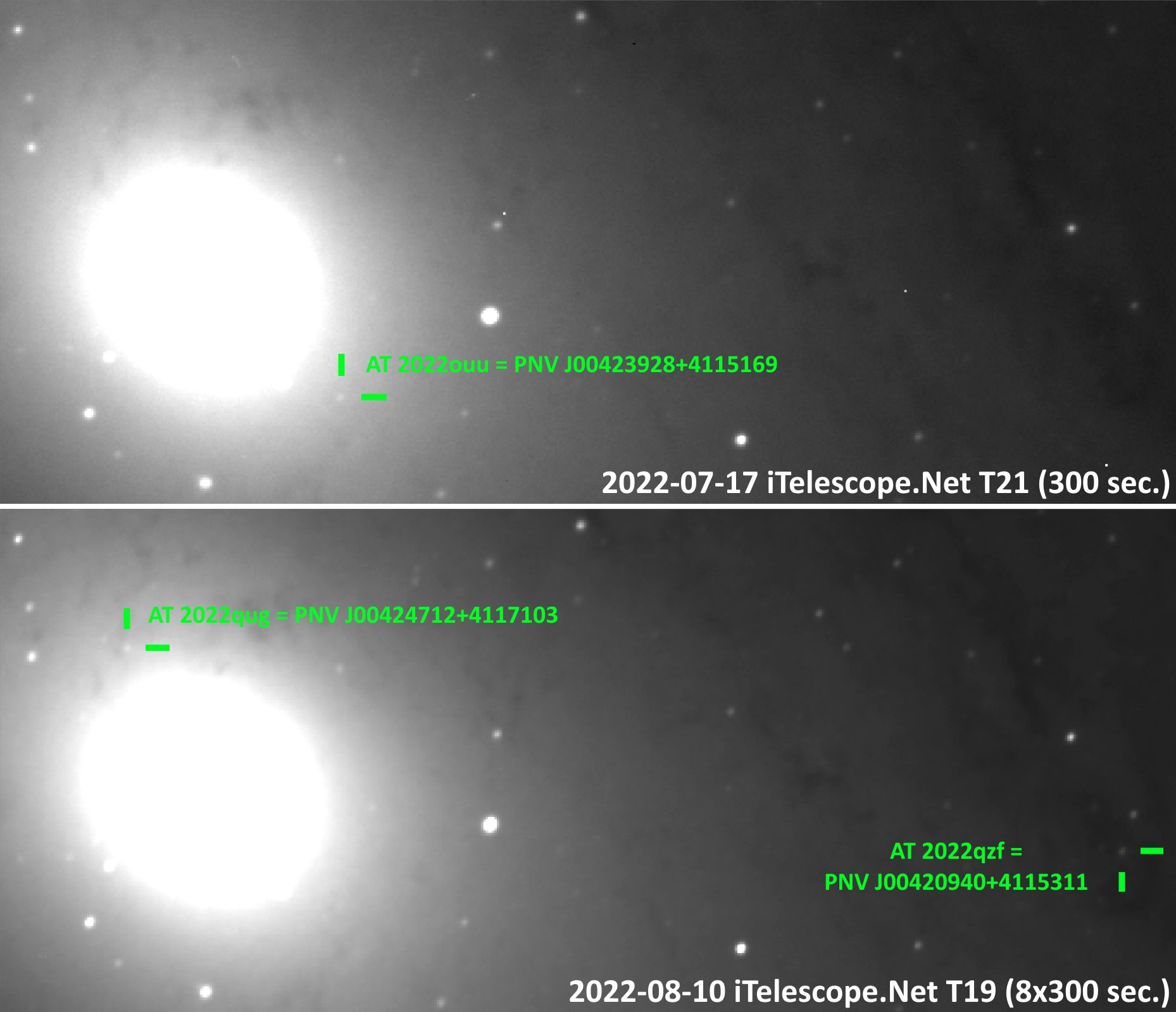EarthSky Community Photos
Submit your photo here. Comment or upvote on photo pages. Search via photographers' names. More improvements coming! To help, please donate.

Remotely using iTelescope.Net telescopes at Mayhill, New Mexico, USA
10:48 am
My discoveries of three novae in M31 (AT 2022ouu, AT 2022qug and AT 2022qzf).
After my discovery of supernova SN 2022bsi https://earthsky.org/todays-image/supernova-discovery-filipp-romanov/ in February 2022, in May I discovered type IIP supernova SN 2022jhn https://www.wis-tns.org/object/2022jhn But in addition to searching for supernovae, since the spring of 2021 I regularly request images of the Andromeda Galaxy from remote telescopes to search for novae. If I found novae in the images, then, when checking, it turned out that they were already discovered by others one-two days before (when there was cloudy weather for imaging of M31 — according to my requests).
On July 14, 2022, I received 3x300 sec. photos (requested through Twitter) taken on this date at the public robotic 0.61-m telescope of Burke-Gaffney Observatory (BGO) https://observatory.smu.ca/ (of Saint Mary's University) in Halifax, Nova Scotia, Canada. I compared them with past photos from July 10th and saw a new star near the center of M31. I checked that this object is not an asteroid and was not known before, measured the position and brightness and sent information about it to the Transient Name Server (TNS) and to the Transient Objects Confirmation Page (TOCP) of the Central Bureau for Astronomical Telegrams, this object has been designated AT 2022ouu https://www.wis-tns.org/object/2022ouu and PNV J00423928+4115169 http://www.cbat.eps.harvard.edu/unconf/followups/J00423928+4115169.html I did multicolor photometry of this object using photographs from remote telescopes and published the combined light curve at the link: https://www.wis-tns.org/system/files/uploaded/F.%20D.%20Romanov/tns_2022ouu_atrep_155325_F._D._Romanov_0.jpg (maximum brightness was around 17.25 mag.). I wrote to several astronomers asking them to obtain the spectrum of the object, but none of them did it; the spectrum was obtained only on August 4 through my observing time at the 2-m Liverpool Telescope. I calibrated and analyzed the spectrum https://www.wis-tns.org/system/files/uploaded/F.%20D.%20Romanov/tns_2022ouu_classrep_13073_F._D._Romanov.jpg and classified AT 2022ouu as Fe II nova in M31. I wrote all the details in the ATel #15569 https://www.astronomerstelegram.org/?read=15569 on 23 August 2022. This is the first nova discovered by me.
On August 7, 2022, I discovered another apparent nova near the center of M31, in the requested 3x300 sec. photos from the Burke-Gaffney Observatory. The transient was designated AT 2022qug https://www.wis-tns.org/object/2022qug in the TNS and PNV J00424712+4117103 http://www.cbat.eps.harvard.edu/unconf/followups/J00424712+4117103.html on the TOCP. It was about 17 mag. at the time of maximum brightness and after me it was also detected by ATLAS sky survey, and the position measured by ATLAS_Bot1 is almost the same as the position measured by me. The spectrum of the object was obtained on August 22 using the 1.82-m Copernico Telescope of Mt. Ekar (near Asiago, Italy) and I am one of the authors of the classification report https://www.wis-tns.org/object/2022qug/classification-cert that AT 2022qug is also Fe II nova in M31.
For follow-up observations of AT 2022qug, I received 3x300 sec. images from 0.43-m iTelescope.Net T21 - on August 7, and 3x300 sec. from 0.61-m iTelescope.Net T24 (in Sierra Remote Observatory at Auberry, California, USA) — on August 9 (because it was cloudy over the BGO on this date). When comparing these images, in the recent photos I found another nova! The object was not close to the center of M31, it was designated AT 2022qzf https://www.wis-tns.org/object/2022qzf in the TNS and PNV J00420940+4115311 http://www.cbat.eps.harvard.edu/unconf/followups/J00420940+4115311.html on the TOCP. This also reached about 17 mag. at the maximum and after me it was detected by ZTF sky survey, and this confirmed the accuracy of my position measurement; ZTF light curve is available here: https://lasair-ztf.lsst.ac.uk/object/ZTF22aazmooy/ The spectrum of AT 2022qzf was obtained at the Palomar 1.5-m telescope on August 14, object has been classified as nova. I see from the spectrum (uploaded to the TNS) that this is also Fe II nova, like the other two.
Usually several groups of astronomers (both professional and amateur) constantly monitor M31 in search for novae, so it is not easy to make such discoveries. During every year, several dozen novae are usually discovered in M31, but not all of them receive confirmation by spectra. All three novae discovered by me were confirmed by spectra, and I hope that these discoveries and my research will be useful for the science.
Now I am the discoverer of 80 variable stars, 2 supernovae, 3 novae in M31, 10 planetary nebulae candidates, 3 astronomical transients (possible supernovae) and 4 pairs of binary stars. By the way, August 17, 2022 was the date of 13 years from the date of the beginning of my study of astronomy by self-education (since August 17, 2009, when I was 12 years old); I made the first astronomical discovery (variable star) in January 2016.
I am attaching my photos of these three novae (all photos were taken using telescopes of iTelescope.Net at Mayhill, New Mexico, USA, with Luminance filters).
With best wishes, Filipp Romanov, amateur astronomer, 25 years old.








